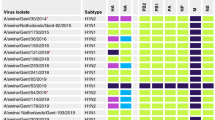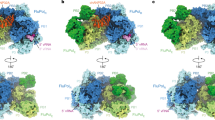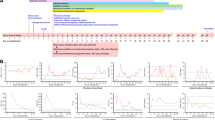Abstract
Understanding the evolutionary adaptations that enable avian influenza viruses to transmit in mammalian hosts could allow better detection of zoonotic viruses with pandemic potential. We applied ancestral sequence reconstruction to gain viruses representing different adaptive stages of the European avian-like (EA) H1N1 swine influenza virus as it transitioned from avian to swine hosts since 1979. Ancestral viruses representing the avian-like precursor virus and EA swine influenza viruses from 1979–1983, 1984–1987 and 1988–1992 were reconstructed and characterized. Glycan-binding analyses showed stepwise changes in the haemagglutinin receptor–binding specificity of the EA swine influenza viruses—that is, from recognition of both α2,3- and α2,6-linked sialosides to recognition of α2,6-linked sialosides only; however, efficient transmission in piglets was enabled by adaptive changes in the viral polymerase protein and nucleoprotein, which have been fixed since 1983. PB1-Q621R and NP-R351K increased viral replication and transmission in piglets when introduced into the 1979–1983 ancestral virus that lacked efficient transmissibility. The stepwise adaptation of an avian influenza virus to a mammalian host suggests that there may be opportunities to intervene and prevent interspecies jumps through strategic coordination of surveillance and risk assessment activities.
This is a preview of subscription content, access via your institution
Access options
Access Nature and 54 other Nature Portfolio journals
Get Nature+, our best-value online-access subscription
$32.99 / 30 days
cancel any time
Subscribe to this journal
Receive 12 digital issues and online access to articles
$119.00 per year
only $9.92 per issue
Buy this article
- Purchase on SpringerLink
- Instant access to full article PDF
Prices may be subject to local taxes which are calculated during checkout





Similar content being viewed by others
Data availability
Sequences of Sanger sequencing validated in the study were deposited to the public database GISAID under the following accession numbers: DK/77, EPI_ISL_539860; A/swine/Arnsberg/6554/1979, EPI_ISL_539869; Be01-lung, EPI_ISL_1055769; Be02-lung, EPI_ISL_1055773; A/swine/Netherlands/3/1980, EPI_ISL_539861; SW/81, EPI_ISL_539862; A/swine/Netherlands/12/1985, EPI_ISL_539863; SW/92, EPI_ISL_539864; A/swine/Hong Kong/8512/2001, EPI_ISL_539865; A/swine/Hong Kong/72/2007, EPI_ISL_539866; A/swine/Hong Kong/1559/2008, EPI_ISL_539867; A/swine/Hong Kong/NS4848/2011, EPI_ISL_539868; RG-EA1, EPI_ISL_539852; RG-EA2, EPI_ISL_539853; RG-EA3, EPI_ISL_539854; and RG-EA4, EPI_ISL_539855. Samples of next-generation sequencing have been deposited in the Sequence Read Archive of the NCBI under project accession number PRJNA725802. Source data are provided with this paper.
References
Kuiken, T. et al. Host species barriers to influenza virus infections. Science 312, 394–397 (2006).
Parrish, C. R. et al. Cross-species virus transmission and the emergence of new epidemic diseases. Microbiol. Mol. Biol. Rev. 72, 457–470 (2008).
Taubenberger, J. K. & Kash, J. C. Influenza virus evolution, host adaptation, and pandemic formation. Cell Host Microbe 7, 440–451 (2010).
Lipsitch, M. et al. Viral factors in influenza pandemic risk assessment. Elife 5, e18491 (2016).
Long, J. S., Mistry, B., Haslam, S. M. & Barclay, W. S. Host and viral determinants of influenza A virus species specificity. Nat. Rev. Microbiol. 17, 67–81 (2019).
Smith, G. J. et al. Origins and evolutionary genomics of the 2009 swine-origin H1N1 influenza A epidemic. Nature 459, 1122–1125 (2009).
Pensaert, M., Ottis, K., Vandeputte, J., Kaplan, M. M. & Bachmann, P. A. Evidence for the natural transmission of influenza A virus from wild ducts to swine and its potential importance for man. Bull. World Health Organ. 59, 75–78 (1981).
Brown, I. H. History and epidemiology of swine influenza in Europe. Curr. Top. Microbiol. Immunol. 370, 133–146 (2013).
Krumbholz, A. et al. Origin of the European avian-like swine influenza viruses. J. Gen. Virol. 95, 2372–2376 (2014).
Joseph, U., Vijaykrishna, D., Smith, G. J. D. & Su, Y. C. F. Adaptive evolution during the establishment of European avian-like H1N1 influenza A virus in swine. Evol. Appl. 11, 534–546 (2018).
Vijaykrishna, D. et al. Long-term evolution and transmission dynamics of swine influenza A virus. Nature 473, 519–522 (2011).
Yang, H. et al. Prevalence, genetics, and transmissibility in ferrets of Eurasian avian-like H1N1 swine influenza viruses. Proc. Natl Acad. Sci. USA 113, 392–397 (2016).
Henritzi, D. et al. Surveillance of European domestic pig populations identifies an emerging reservoir of potentially zoonotic swine influenza A viruses. Cell Host Microbe 28, 614–627 (2020).
Dornfeld, D., Petric, P. P., Hassan, E., Zell, R. & Schwemmle, M. Eurasian avian-like swine influenza A viruses escape human MxA restriction through distinct mutations in their nucleoprotein. J. Virol. 93, e00997-18 (2019).
Sun, H. et al. Prevalent Eurasian avian-like H1N1 swine influenza virus with 2009 pandemic viral genes facilitating human infection. Proc. Natl Acad. Sci. USA 117, 17204–17210 (2020).
Thornton, J. W., Need, E. & Crews, D. Resurrecting the ancestral steroid receptor: ancient origin of estrogen signaling. Science 301, 1714–1717 (2003).
Ducatez, M. F. et al. Feasibility of reconstructed ancestral H5N1 influenza viruses for cross-clade protective vaccine development. Proc. Natl Acad. Sci. USA 108, 349–354 (2011).
Rogers, G. N. & Paulson, J. C. Receptor determinants of human and animal influenza virus isolates: differences in receptor specificity of the H3 hemagglutinin based on species of origin. Virology 127, 361–373 (1983).
Baumann, J., Kouassi, N. M., Foni, E., Klenk, H. D. & Matrosovich, M. H1N1 swine influenza viruses differ from avian precursors by a higher pH optimum of membrane fusion. J. Virol. 90, 1569–1577 (2016).
Russier, M. et al. H1N1 influenza viruses varying widely in hemagglutinin stability transmit efficiently from swine to swine and to ferrets. PLoS Pathog. 13, e1006276 (2017).
Pleschka, S. et al. A plasmid-based reverse genetics system for influenza A virus. J. Virol. 70, 4188–4192 (1996).
Salomon, R. et al. The polymerase complex genes contribute to the high virulence of the human H5N1 influenza virus isolate A/Vietnam/1203/04. J. Exp. Med. 203, 689–697 (2006).
Thornton, J. W. Resurrecting ancient genes: experimental analysis of extinct molecules. Nat. Rev. Genet. 5, 366–375 (2004).
Giles, B. M. & Ross, T. M. A computationally optimized broadly reactive antigen (COBRA) based H5N1 VLP vaccine elicits broadly reactive antibodies in mice and ferrets. Vaccine 29, 3043–3054 (2011).
Taubenberger, J. K. & Morens, D. M. The 1918 influenza pandemic and its legacy. Cold Spring Harb. Perspect. Med. 10, a038695 (2020).
Reid, A. H., Fanning, T. G., Janczewski, T. A., Lourens, R. M. & Taubenberger, J. K. Novel origin of the 1918 pandemic influenza virus nucleoprotein gene. J. Virol. 78, 12462–12470 (2004).
Gabriel, G., Herwig, A. & Klenk, H. D. Interaction of polymerase subunit PB2 and NP with importin α1 is a determinant of host range of influenza A virus. PLoS Pathog. 4, e11 (2008).
Gabriel, G. et al. Differential use of importin-α isoforms governs cell tropism and host adaptation of influenza virus. Nat. Commun. 2, 156 (2011).
Zimmermann, P., Mänz, B., Haller, O., Schwemmle, M. & Kochs, G. The viral nucleoprotein determines Mx sensitivity of influenza A viruses. J. Virol. 85, 8133–8140 (2011).
Mänz, B. et al. Pandemic influenza A viruses escape from restriction by human MxA through adaptive mutations in the nucleoprotein. PLoS Pathog. 9, e1003279 (2013).
Ashenberg, O., Padmakumar, J., Doud, M. B. & Bloom, J. D. Deep mutational scanning identifies sites in influenza nucleoprotein that affect viral inhibition by MxA. PLoS Pathog. 13, e1006288 (2017).
Stamatakis, A. RAxML version 8: a tool for phylogenetic analysis and post-analysis of large phylogenies. Bioinformatics 30, 1312–1313 (2014).
Finnigan, G. C., Hanson-Smith, V., Stevens, T. H. & Thornton, J. W. Evolution of increased complexity in a molecular machine. Nature 481, 360–364 (2012).
Tamuri, A. U. Treesub: annotating ancestral substitution on a tree. Github https://github.com/tamuri/treesub (2013).
Stech, J. et al. Rapid and reliable universal cloning of influenza A virus genes by target-primed plasmid amplification. Nucleic Acids Res. 36, e139 (2008).
Hoffmann, E., Neumann, G., Kawaoka, Y., Hobom, G. & Webster, R. G. A DNA transfection system for generation of influenza A virus from eight plasmids. Proc. Natl Acad. Sci. USA 97, 6108–6113 (2000).
Hoffmann, E., Neumann, G., Hobom, G., Webster, R. G. & Kawaoka, Y. ‘Ambisense’ approach for the generation of influenza A virus: vRNA and mRNA synthesis from one template. Virology 267, 310–317 (2000).
Moncorge, O. et al. Investigation of influenza virus polymerase activity in pig cells. J. Virol. 87, 384–394 (2013).
Zhu, H. et al. Infectivity, transmission, and pathology of human-isolated H7N9 influenza virus in ferrets and pigs. Science 341, 183–186 (2013).
Nishiura, H., Yen, H. L. & Cowling, B. J. Sample size considerations for one-to-one animal transmission studies of the influenza A viruses. PLoS ONE 8, e55358 (2013).
Reed, L. J. & Muench, H. A simple method of estimating fifty percent endpoints. Am. J. Hyg. 27, 493–497 (1938).
Katoh, K., Misawa, K., Kuma, K. & Miyata, T. MAFFT: a novel method for rapid multiple sequence alignment based on fast Fourier transform. Nucleic Acids Res. 30, 3059–3066 (2002).
Miller, M. A., Pfeiffer, W. & Schwartz, T. Creating the CIPRES Science Gateway for inference of large phylogenetic trees. In 2010 Gateway Computing Environments Workshop (GCE) 1–8 (IEEE, 2010).
Bruinsma, S. et al. Bead-linked transposomes enable a normalization-free workflow for NGS library preparation. BMC Genomics 19, 722 (2018).
Schindelin, J. et al. Fiji: an open-source platform for biological-image analysis. Nat. Methods 9, 676–682 (2012).
Acknowledgements
We thank the St. Jude core facilities, including the Animal Resources Centre and the Veterinary Pathology Core for technical support. This study was supported by contract HHSN272201400006C from NIAID, NIH, USA, and the Theme-Based Research Scheme (grant nos T11-705/14N and T11-712/19-N) from the Research Grants Council, Hong Kong SAR, China. Y.C.F.S., U.J., J.J. and G.J.D.S. are supported by the Duke–NUS Signature Research Programme funded by the Ministry of Health, Singapore.
Author information
Authors and Affiliations
Contributions
H.-L.Y., G.J.D.S. and R.J.W. conceived and designed the experiments. W.S., Y.C.F.S., U.J., J.J. and G.J.D.S. performed the sequence analyses. W.S., Y.Z., M.Z. and Y.J. performed in vitro experiments. W.S. and H.T.B. performed ex vivo experiments. W.S., R.H., J.D., J.-C.C., T.J., A.R., J.F., P.N.Q.P., C.K., J.C.J. and L.K. performed in vivo animal experiments. S.K., S.P., M.C.W.C., R.G.W., C.-Y.W., K.V.R. and M.P. provided novel reagents to support the study. W.S., Y.C.F.S., G.J.D.S., R.J.W., M.P. and H.-L.Y. wrote the draft manuscript, and all authors reviewed the paper.
Corresponding authors
Ethics declarations
Competing interests
The authors declare no competing interests.
Additional information
Peer review information Nature Microbiology thanks Eric Gaucher, Larisa Rudenko and the other, anonymous, reviewer(s) for their contribution to the peer review of this work. Peer reviewer reports are available.
Publisher’s note Springer Nature remains neutral with regard to jurisdictional claims in published maps and institutional affiliations.
Extended data
Extended Data Fig. 1 Receptor binding profile of avian and EA swine influenza A viruses.
An ELISA-based assay was employed to investigate receptor binding preference of avian and EA swine H1N1 influenza viruses. 3'SLN (shown in cyan circles) and 6'SLN (shown in pink squares) were coated in 96-well plates at concentrations of 5 to 0.1 µg/ml. Infectious viruses (diluted to 64 HAU/50µL) were added to each well and co-incubated with 3'SLN and 6'SLN. The plates were washed with PBS and the detection of bound virus was done using a rabbit polyclonal antibody against HA from A/Duck/NZL/160/1976(H1N3) (Sino Biological Inc., Beijing, China) followed by polyclonal Goat Anti-Rabbit Immunoglobulins/HRP (Dako, Denmark). The absorbance at 450 nm was plotted against glycan concentration. Results are shown with the mean and s.d. absorbance from 3 replicates in one of two independently performed experiment.
Extended Data Fig. 2 EA swine virus sequence from archived pig-lung homogenates in 1979 shared high homology with the ancestral sequence of RG-EA2 that genetically resembles 1979–1983 era EA swine viruses.
Full genome of A/swine/Belgium/2/1979 (Be02-lung) and a partial genome of A/swine/Belgium/1/1979 (Be01-lung) EA swine influenza viruses were sequenced from two archived pig-lung homogenates from 1979. Four recombinant viruses were resurrected using ancestral sequence reconstruction, with RG-EA1 representing the precursor virus of EA swine viruses, RG-EA2 representing the early evolutionary stage of EA swine viruses in 1979–1983, and RG-EA3 and RG-EA4 representing EA swine viruses in 1984–1987 and 1988–1992, respectively. Among the 33 amino acids that differentiate the non-transmissible RG-EA2 virus and transmissible RG-EA3 virus, the sequences of Be01 and Be02 showed high homology to RG-EA2. /, unsuccessfully determined.
Extended Data Fig. 3 Structure of glycans used for glycan array.
A synthesised glycan microarray comprised of 38 glycans of 𝛼2,3-linked sialosides (glycan 1–38), 3 glycans containing both 𝛼2,3 & 𝛼2,6-linked sialosides (glycan 39–41) and 32 glycans of 𝛼2,6-linked sialosides (glycan 42–73) was utilized for glycan array assay.
Supplementary information
Supplementary Information
Supplementary Methods, Supplementary Figs. 1,2 and Supplementary Tables 1–7.
Source data
Source Data Fig. 1
Numerical source data for Fig. 1.
Source Data Fig. 2
Numerical source data for Fig. 2b–h.
Source Data Fig. 3
Numerical source data for Fig. 3.
Source Data Fig. 4
Numerical source data for Fig. 4.
Source Data Fig. 5
Numerical source data for Fig. 5a–c,e–h.
Source Data Extended Data Fig. 1
Numerical source data for Extended Data Fig.1.
Rights and permissions
About this article
Cite this article
Su, W., Harfoot, R., Su, Y.C.F. et al. Ancestral sequence reconstruction pinpoints adaptations that enable avian influenza virus transmission in pigs. Nat Microbiol 6, 1455–1465 (2021). https://doi.org/10.1038/s41564-021-00976-y
Received:
Accepted:
Published:
Issue date:
DOI: https://doi.org/10.1038/s41564-021-00976-y
This article is cited by
-
GGCX promotes Eurasian avian-like H1N1 swine influenza virus adaption to interspecies receptor binding
Nature Communications (2025)
-
Evolutionary insights into the stereoselectivity of imine reductases based on ancestral sequence reconstruction
Nature Communications (2024)
-
Human-type sialic acid receptors contribute to avian influenza A virus binding and entry by hetero-multivalent interactions
Nature Communications (2022)



